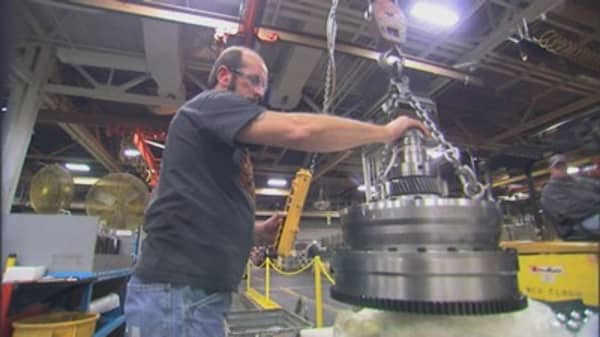When an economic recovery boosts hiring, wages are supposed to go up.
That's why many economists are scratching their heads after the latest quarterly data Friday showed that overall compensation in the three months ending in June inched up at the slowest pace since 1982.
"This report was a bit of a shock since it is not what is expected in a gradually tightening labor market," said Ozlem Yaylaci, U.S. economist at IHS Global Insight.
The government employment cost index—which tracks wages benefits and other compensation—edged up a meager 0.2 percent in the second quarter, after rising by 0.7 percent in the first three months of the year. That puts the index just 2.0 percent ahead of last year's second quarter, down from a year-over-year gain of 2.6 percent in the first quarter.
That's not supposed to happen as labor markets tighten, employers have a harder time filling jobs and workers find themselves in a better bargaining position for higher wages. Since peaking in the depths of the recession, the U.S. unemployment rate has fallen nearly in half, to 5.3 percent last month. New claims for unemployment insurance recently fell to their lowest level since 1973. And a number of large companies and state and local governments have also begun boosting the minimum wage.
So why aren't workers seeing a bump in their paychecks?
One reason may be that employers are getting stingier with benefits, which make up a portion of the employment cost index, according to private economist Joel Naroff.
"The decline in benefits (in the latest data) was only the second time that has happened," he said.
The upward pressure on wage growth may also be tempered by weakness in the economy that may not be showing up the optimistic jobs data. The government's latest report on gross domestic product showed the U.S. economy grew at an annual rate of 2.3 percent in the latest quarter. But the Commerce Department also marked down its growth numbers for prior years.
"The revisions show a recovery from the Great Recession that has been lackluster," according to economists at PNC Financial.
The weak gains in worker compensation may also reflect a shift in the type of employment being created since the Great Recession shrank U.S. payrolls by some 8.7 million jobs.
Strong hiring in the leisure and hospitality sector, for example, has boosted its share of overall employment by 0.7 percentage points to 10.7 percent, notes Kathy Bostjancic, financial markets economist at Oxford Economics. But those workers on average earned just $12.37 an hour in June, about half the $24.95 an hour paid to all private nonfarm workers.
"The rising share of lower-paid leisure and hospitality workers mutes the overall average hourly earnings gauge," she said. "As lower-earning service jobs are created and garner a larger share of overall employment, it weighs down on the average hourly earnings measure."
Since the recession ended in the second quarter of 2009, the average pay gain for all workers amounted to about 12 percent, as measured by the ECI. But the individual gains have varied widely from one industry to another.




